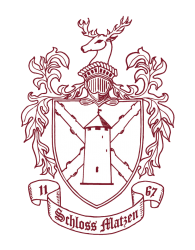The history of the castle & its surrounds
Already in the Bronze Age the well protected hill of Matzen was a residential place. The Roman "Masciacum" was built to secure the Roman road in the Inn valley.
In the 12th century the castle Matzen was built in Romanesque style. Owners and appearance of the castle changed over the centuries. Today, the guest rooms are named after the various owners of the castle.
The castle is mentioned for the first time in 1167, in possession of the Knight of Frundsberg.
The castle is mentioned for the first time in 1167, in possession of the Knight of Frundsberg.
After two Romanesque building periods, during the Frundsberg ownership until 1468, still a Gothic building period led to a significant expansion of the castle.
1468 Matthias Türndl bought Matzen. Short term it came into possession of the Ross family until 1521 and passed then into the possession of the Fieger. This gave Matzen its present form.
Among the Fieger and partly under the Fugger family, who also was an owner of Matzen in the 16th Century the castle was converted into a residential palace. Beside, the Fieger created the arcades which connect the different wings with each other and give the courtyards their picturesque charm.
Matthias Pock, which owned Matzen from 1658 to 1684, designed the chapel, originally in a late Gothic style.
In the era of the Rococo around 1684 Johann Ferdinand Yrsch bought the castle, who sold it in 1734 to Joseph Ruppert of Pfeiffersberg. 1776 the Pfeiffersberg family was put under guardianship by the state government. Under the ownership of the Pfeiffersberg family Matzen burned down and became a ruin.
1873 Matzen was bought by the Irish lady Fanny Reade of Mount Heaton-Grohmann and rescued the historic jewel before its final decline. Her son, William Adolf Baillie Grohman, was an avid fan of Tyrol, mountaineer and author. Among others, he wrote books about Tyrol and his domestic shrines (Tyrol and the Tyrolese (1876). Through these books, the British and Americans Tirol were made known. One of his (hunting) Friends was U.S. President Theodore Roosevelt, who spent much time at the castle Matzen.
During World War II in Schloss Matzen the stocks of the Tiroler Landesmuseum Ferdinandeum and the Tyrolean library were kept.
Until 1957 Schloss Matzen was owned by Captain Tom Michael Baillie Grohman, who used the palace as a summer residence until it was sold to the architect Ernest Kump from Bakersfield, California. 2008, it was finally taken over by the current owners and with a lot of effort completely renovated.
The Schloss Matzen is one of the most historic sites in the Tyrol. It is known for its Romanesque “Bergfried” – the tower (the upwardly tapering "churn tower" is unique in Northern Tyrol), for its perimeter wall and the several courtyards with the arcades.
Inside the castle there are other historical jewels. Gothic chapel with baroque altar, the barrel-vaulted Knight's Hall with a fireplace and a library with antique hunting trophies.
The castle is surrounded by the 200,000 sqm Matzenpark, which can be visited directly from the castle. The park is one of the most beautiful and valuable natural monuments in the Tyrol. Below the castle, Gut Matzen is located and welcomes its guests in its beautifully designed restaurant, café and in the romantic garden restaurant.
1468 Matthias Türndl bought Matzen. Short term it came into possession of the Ross family until 1521 and passed then into the possession of the Fieger. This gave Matzen its present form.
Among the Fieger and partly under the Fugger family, who also was an owner of Matzen in the 16th Century the castle was converted into a residential palace. Beside, the Fieger created the arcades which connect the different wings with each other and give the courtyards their picturesque charm.
Matthias Pock, which owned Matzen from 1658 to 1684, designed the chapel, originally in a late Gothic style.
In the era of the Rococo around 1684 Johann Ferdinand Yrsch bought the castle, who sold it in 1734 to Joseph Ruppert of Pfeiffersberg. 1776 the Pfeiffersberg family was put under guardianship by the state government. Under the ownership of the Pfeiffersberg family Matzen burned down and became a ruin.
1873 Matzen was bought by the Irish lady Fanny Reade of Mount Heaton-Grohmann and rescued the historic jewel before its final decline. Her son, William Adolf Baillie Grohman, was an avid fan of Tyrol, mountaineer and author. Among others, he wrote books about Tyrol and his domestic shrines (Tyrol and the Tyrolese (1876). Through these books, the British and Americans Tirol were made known. One of his (hunting) Friends was U.S. President Theodore Roosevelt, who spent much time at the castle Matzen.
During World War II in Schloss Matzen the stocks of the Tiroler Landesmuseum Ferdinandeum and the Tyrolean library were kept.
Until 1957 Schloss Matzen was owned by Captain Tom Michael Baillie Grohman, who used the palace as a summer residence until it was sold to the architect Ernest Kump from Bakersfield, California. 2008, it was finally taken over by the current owners and with a lot of effort completely renovated.
The Schloss Matzen is one of the most historic sites in the Tyrol. It is known for its Romanesque “Bergfried” – the tower (the upwardly tapering "churn tower" is unique in Northern Tyrol), for its perimeter wall and the several courtyards with the arcades.
Inside the castle there are other historical jewels. Gothic chapel with baroque altar, the barrel-vaulted Knight's Hall with a fireplace and a library with antique hunting trophies.
The castle is surrounded by the 200,000 sqm Matzenpark, which can be visited directly from the castle. The park is one of the most beautiful and valuable natural monuments in the Tyrol. Below the castle, Gut Matzen is located and welcomes its guests in its beautifully designed restaurant, café and in the romantic garden restaurant.
